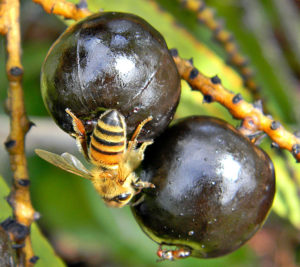Saw palmetto – or saw palmetto – is a palm-like plant native to the southeastern United States.
The extract of the saw palmetto fruit is used to make medicines, both herbal and pharmaceutical.
Saw palmetto is best known for its ability to reduce the symptoms of benign enlargement of the bladder neck gland (also called enlarged prostate).
Although the scientific studies on saw palmetto's effect on enlarged prostate have produced conflicting results, most experts today consider saw palmetto to be a good and natural treatment option.

It's the extract of saw palmetto berries used to make medicine
The effect of saw palmetto on enlarged prostate
Benign enlargement of the bladder neck gland, also known as enlarged prostate or benign prostatic hyperplasia in Latin, is a disease that primarily affects middle-aged and older men. The disease particularly affects men's tendency to urinate as the enlarged bladder neck gland presses on the urethra that carries urine out of the body. This pressure therefore causes various urinary problems.
There are several studies on the effect of saw palmetto on enlarged prostate, but the results of these have been mixed or even contradictory. Many of the studies have shown that saw palmetto can be used to treat the symptoms (e.g. too frequent urination, difficulty starting or stopping urination and the need to urinate during the night).
Some studies also show that saw palmetto is as effective in treating the symptoms of the disease as the chemical drug finasteride, but that saw palmetto does not cause any side effects including decreased sexual drive. Other studies have indicated that saw palmetto can even reduce the size of the bladder neck gland. The main problem with these studies has been their short duration (less than 3 months), which does not make them useful as a basis for drawing definitive conclusions about whether or not saw palmetto can be used to prevent the possible complications of enlarged prostate.
Other health uses
Although saw palmetto is primarily used for enlarged prostate, some people also use it for other health purposes. However, these uses are not clinically proven.
Saw palmetto is used for, among other things:
- Common colds
- Sore throat
- Asthma
- Chronic bronchitis
- Reducing bleeding after prostate surgery
- Migraines
- Headaches
- Chronic pelvic pain syndrome
- Hair loss and baldness
- Increase in breast size
In addition, saw palmetto is also used to increase urination (as a diuretic), increase sex drive (as an aphrodisiac) and to relax the body (as an anesthetic). However, these uses are not scientifically proven.
It should be emphasized that there is no scientific evidence that saw palmetto can be used for any of the above health problems.
Precautionary measures
Saw palmetto should not be taken in the following cases:
- Pregnancy and breastfeeding: Pregnant and breastfeeding women should not use saw palmetto because saw palmetto acts as a hormone, which can be dangerous to health during pregnancy and breastfeeding.
- Surgery: Saw palmetto can inhibit the blood's ability to clot (coagulate). Therefore, it is thought that saw palmetto may increase bleeding during and after surgery. It is therefore recommended to stop taking saw palmetto at least 2 weeks before the day of surgery.
Side effects of saw palmetto
Although there are generally few side effects when using saw palmetto, there is always a risk that they may occur. When side effects do occur, they are usually mild. The known side effects of saw palmetto are:
- Dizziness
- Headaches
- Nausea
- Vomiting
- Constipation
- Diarrhea
In some cases, impotence has also been reported as a side effect, but subsequent studies have shown that the incidence of these is no more frequent than in men taking sugar pills (placebo).
In addition, there have been a few cases where saw palmetto has been suspected of causing damage to the liver (two cases) and pancreas (one case). However, there is insufficient information to determine whether saw palmetto was the actual cause of the organ damage in these three cases.
Interactions
- Birth control pills: Some birth control pills contain estrogen and because saw palmetto can decrease the level of estrogen in the body, saw palmetto can decrease the effectiveness of birth control pills. Talk to your doctor or gynecologist about using saw palmetto in combination with birth control pills.
- Estrogen: As mentioned above, saw palmetto can decrease the body's level of estrogen. If you are taking estrogen pills, you should be aware of this interaction. Talk to your doctor if you are taking estrogen pills and want to take saw palmetto at the same time.
- Medication that reduces blood clotting ability: Saw palmetto should generally not be taken with other medications that reduce blood clotting ability, as this may increase the risk of bleeding in some people (saw palmetto also reduces the ability of blood to clot). This applies to chemical medications (e.g. anticoagulants) as well as herbal remedies and supplements such as angelica, cloves, garlic, ginger, gingko, ginseng, red clover, turmeric, willow, vitamin E and others. Talk to your doctor or pharmacist if in doubt.
The story behind the saw palmetto
Saw palmetto fruits are black, green and brownish berries similar in size to olives. Saw palmetto fruits were originally eaten and used as a natural medicine by Native Americans in the southeastern part of the United States, where saw palmetto originated (today it is common in several parts of the US).
In the early 1900s, immigrant American men began using saw palmetto fruits to treat urinary tract problems as well as to increase sperm production and strengthen their sex drive.

Saw palmetto grows only in the United States and is native to the southeast (Florida)
Today, as mentioned, saw palmetto is used to treat the symptoms of enlarged prostate, which is now a recognized use, but also to treat a wide range of other health problems that are not considered to be recognized.
Other names
Saw palmetto is also known as saw palmetto, which is the English name. In Latin, the plant is called Serenoa repens, although the erroneous botanical names Serenoa serrulata and Sabal serrulata are sometimes encountered in literature and on the internet.
